1971 Monaco Grand Prix race report
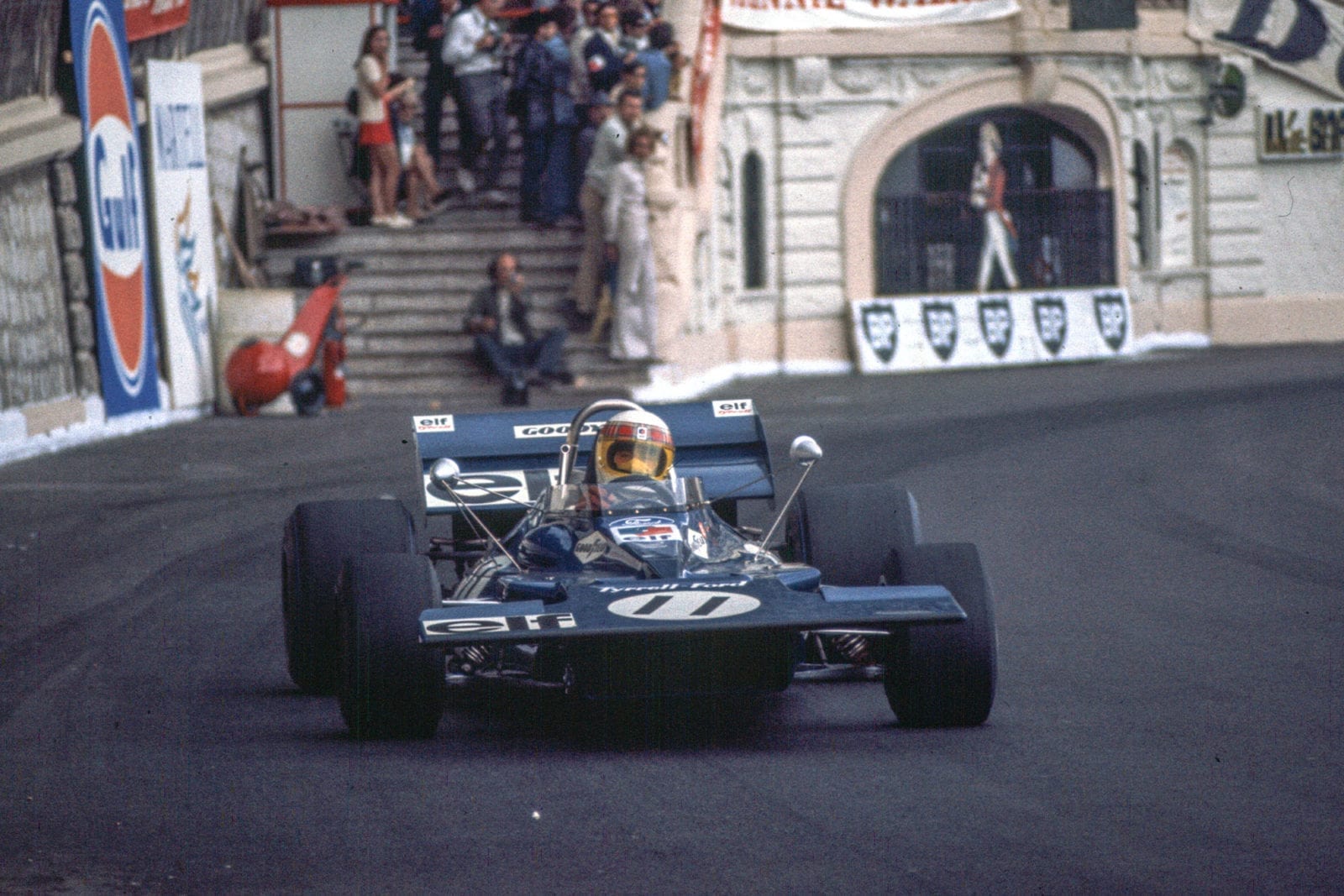
Jackie Stewart claimed his second win of the season for Tyrrell
Motorsport Images
Stewart all the way
Monte Carlo, May 23rd.
For some strange and seemingly masochistic reason everyone wants to compete in the Monaco Grand Prix and, equally, everyone would like to inscribe their name on the long list of winners. It is probably due to the relative unavailability of the circuit, for it is only in use by racing cars once a year and there is never any opportunity to do any private test driving on the circuit or any pre-race meeting practice, as there is with most permanent circuits on private ground. Silverstone, Brands Hatch, Monza or Nurburgring you can go to at almost any time of the year and drive your racing car, but not at Monte Carlo, so that every occasion is a rare and valuable one, and the chance to race through the streets of the world-famous principality, in front of the Prince and Princess of Monaco themselves cannot be equalled anywhere else in the world.
By the standards of the so-called “modern safety requirements” that cause trouble at Spa, vast modifications at Nurburgring and the virtual abandonment of street-racing in other countries, the circuit through the streets of Monte Carlo is a joke, with its complete lack of a fenced-off pit road, hairpin bends with no escape roads, kerbstones and brick walls, spectators within a few feet of the passing cars and, to cap it all, a tunnel with a curve in the middle of it. The circuit has just about everything that the “improvers” are trying to eliminate on other circuits, yet everyone clamours for an entry at Monaco and accepts a limitation of starters imposed by the autocratic Automobile Club of Monaco under the leadership of Jacques Taffe and Claude Fin.
Perhaps it is all because it started in 1929 and that, apart from minor details, the circuit has remained unchanged since that day, even though Monte Carlo has been almost totally rebuilt over the years; many of the old hotels being replaced by sleek skyscrapers, the gasworks being removed completely, the station being moved to a new site, the trainlines being re-routed, an old train tunnel turned into a motor road, a new elevated road being made and yet the shape and character of the roads used for the circuit are unchanged. Where the racing cars blast along the harbour front, you are still not allowed to drive on non-race days and you are still not allowed to ride a motorcycle through the Casino square, while you must drive your car anti-clockwise round the square, whereas the racing cars circulate clockwise. One French paper summed it all up by asking whether the Grand Prix of Monaco had grown up with the town or whether the town had grown up with the Grand Prix circuit?
To add to this strange and irrational attitude to the Monaco Grand Prix Stewart wrote a piece for the “powder-puff press” saying that if he was limited to driving in only one Grand Prix each year he would choose the Monaco Grand Prix. If he ever has an accident at Monaco and frightens himself, as he did at Spa in 1966, I think he would change his tune.
Qualifying
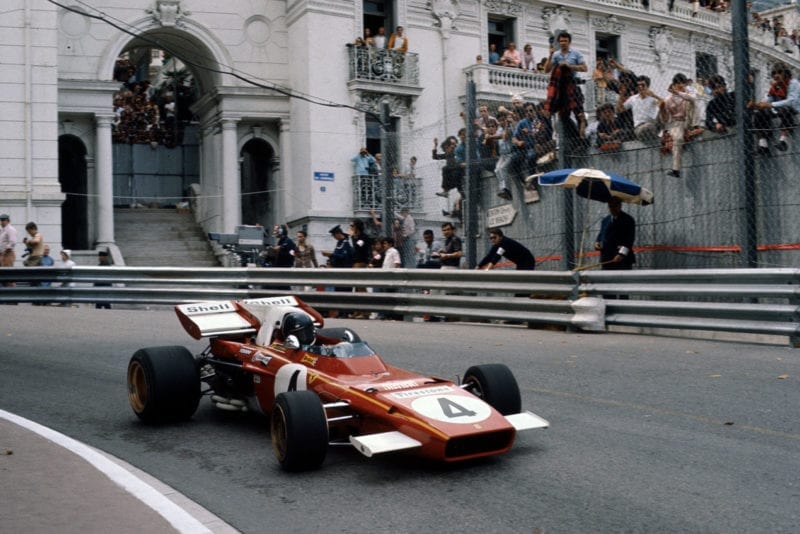
Jacky Ickx qualified 2nd behind Stewart
Motorsport Images
The practice time for the Grand Prix was four hours, divided into one and a half hours on Thursday afternoon, one hour early Friday morning and one and a half hours on Saturday afternoon, during which time all 23 entries could thrash round as much as they wished and at the end of it all the fastest 18 would be allowed to start in the race. This year there was no “Mayfair agreement” or “Geneva agreement” or even a “Gorgonzola agreement”, which meant no pre-arranged favouritism; it was quite simply the 18 fastest, though the timekeeper’s word was law. A lot of people seem to think that this system results in a fiendish last-minute dice by everyone, where in plain fact the only dicing that is necessary is by the odds and ends who occupy the last two or three rows of the starting grid.
Even before things got under way on Thursday the rain began, and got worse and worse as the official hour and a half dragged on. The pits were jam-packed with cars and drivers, Fittipaldi and Wisell with the two Lotus 72 models, Ickx, Regazzoni and Andretti with the Ferraris, Hill and Schenken with the Brabhams, Hulme and Gethin with the McLarens, Stewart and Cevert with the Tyrrells, Rodriguez, Siffert and Ganley with the BRMs, Peterson, Soler-Roig, Galli, Pescarolo and newcomer Barber with the March 711s, Amon and Beltoise with the Matra-Simcas and Surtees and Stommelen with the Surtees cars. Never was quite such a fully-equipped, ready-to-go, collection of Grand Prix talent and machinery so reluctant for the starting signal to be given. Rain on the second or third practice session often happens at Monte Carlo, but such rain before anyone had even turned a wheel was more depressing than can be imagined. So many designs had never been on the circuit before; Tyrrell, Surtees, March 711, Lotus 72, the new Ferrari, McLaren and Brabham models, they all had so much to learn and time was so short.
Black visors and air ducts can alleviate the troubles of a too hot sun, but rain is difficult to stop so that the first practice became a bit of a fiasco and those who ventured out did so more in fear of the rain continuing through to race day than with the hope of learning or proving anything. Andretti, with his South African victory to uphold was trying Monaco for the first time and hating every one of the 119.1 sec. that it took him on his fastest lap. His only consolation was that Stewart took 129.9 for his best lap and called it a day. Something got into Amon and he did heroic things with the Matra to go round in 108.8 sec., his heavy braking for the hairpins being awe-inspiring to watch. He was the only one to get below 1 min. 50 sec. (110 sec.), though Wisell, Hill, Beltoise, Surtees and Rodriguez were heroes as the Practice Times first column indicated. So bad were the conditions that the organisers cancelled the practice for the Formula Three supporting race, which was a wise decision in view of the way some of the up-and-coming stars can have accidents under perfect conditions.
Friday morning was at least dry but by no means bright in the normal sense of Monte Carlo weather, and practice was a bit late as the Formula Three chaps were given extra time to compensate for the cancelled practice. When the Grand Prix field was released there was a mad rush for no one believed that the dry weather was going to last and an instant quick lap time was essential. Stewart was away first, followed by the rest and there was so much traffic that any fast times were impossible, like the speed in the fast lane of a Motorway being controlled by the flat-out VW.
Fairly soon the mad rush subsided as cars stopped to have adjustments made and with more room available some semblance of reality began to emerge. Bogey time was obviously the lap record, which stood at 1 min. 23.2 sec., but as this had been set by the late Jochen Rindt on the last lap of the 1970 race when he was fully wound-up in his chase of Brabham, no one felt very confident that they could match it in stone-cold unemotional conditions, even given more b.h.p., better cars, better tyres, better brakes and all the other improvements made in 12 months’ racing development. Stewart, Ickx and Rodriguez were setting the pace, their lap times getting down below 1 min. 25.0 sec., which meant that creditable times by drivers like Peterson, Gethin, Regazzoni and Wisell were being overshadowed. After a few laps with the new radiator cowling on his new Tyrrell Stewart reverted to the original nose with the wide, flat aerofoil and left everyone overshadowed with a lap in 1 min. 23.2 sec., equalling the record.
While Stewart was having his glory others were having their despair. notably Andretti whose Ferrari engine had died in the Casino square when the fuel-injection system stopped working. He coasted downhill to the sea front in an endeavour to get it started but to no avail, so he was stranded on the far side of the circuit. As he was still learning his way round and was still trying to get used to the confined spaces of the circuit, a feature of the Barcelona circuit that troubled him, he had not made any very fast laps and everyone was in front of him on the starting grid list except Galli, as the Alfa Romeo-engined March 711 was popping and banging with fuel starvation trouble due to installation problems, Soler-Roig because his March 711 had shed a rear wheel due to poor inspection back at the factory letting a machining error creep through, and Barber who never got going at all as his gearbox was all wrong.
On Saturday afternoon two heats of the Formula Three race were held in the dry, but heavy rain clouds were coming over the mountains and before the last Grand Prix practice began rain was falling once again. The outcome was settled before anyone went out, the Friday morning times were going to settle the grid, Andretti would be a nonstarter and the dividing line was drawn between Schenken and Ganley, that inseparable pair that contrive to record almost identical performances everywhere, even though they drive diametrically opposed types of car, which must prove something or other.
Schenken was “in” and Ganley was “out”, with half a second between them. As lots of teams had installed rebuilt engines, or had cured previous troubles there was a surprising amount of activity, even though none of it could alter the starting grid. Surtees and Stommelen did some filming with their camera car, the Alfa Romeo engine was made to go properly, Cevert overdid the bedding-in of the new twin-disc Girling brakes and cracked a disc, and Andretti went round in his own car and the spare one, but without any hope. Towards the end of the session the rain stopped and the road began to dry, but not enough to be significant, and everyone tried surprisingly hard, just in case they were going to have to race under the same conditions. It was Siffert who made fastest lap as the roads were drying, with 1 min. 31.8 sec., a long way off bogey-time, and quite a long way off the last qualifying time, which was Schenken’s 1 min. 28.3 sec. on the previous day.
While the Grand Prix “circus” returned rather gloomily to their workshops an elated David Walker dealt very convincingly with the French Renault-Alpine and Italian Tecno opposition in the Formula Three final, winning the 24-lap race in his works-supported Lotus 69 with Italian Novamotor Ford engine.
Race
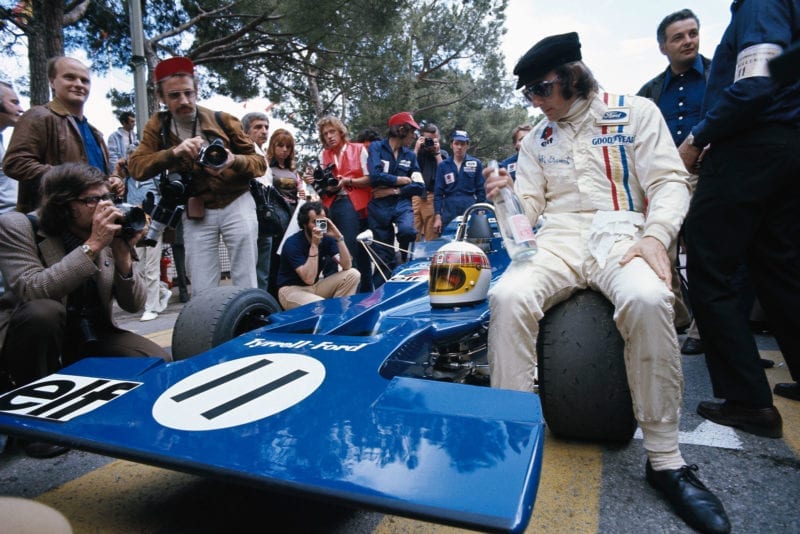
Jackie Stewart contemplates his Tyrrell
Motorsport Images
Although Sunday was bright and sunny there were still ominous clouds over the mountains behind Monte Carlo, but all morning huge crowds poured into the principality, parking was impossible and walking was the only means of movement. The whole town was overflowing with spectators as Prince Rainier officially closed the roads at the wheel of a Jaguar V12 Roadster, and the 18 starters assembled ready for a warm-up lap. Sixteen of them got away all right, Amon was delayed as his Matra V12 would not generate enough pressure in its injection system, and Regazzoni missed his lap as the fire-extinguisher system went off inadvertently and there was a panic to fit another extinguisher container. Stewart zoomed round in the Tyrrell 003, confident that he had the best engine that Cosworth could supply, and that his pit were well prepared with tyres and pneumatic wheel-nut spanners at the ready should rain develop, necessitating a stop for “wet weather” Goodyears. The others followed him round at intervals, Peterson using some new Firestone tyres on his March, as were the two Lotus drivers.
These were a new compound smooth tyre, reckoned to give increased cornering power, but lack of testing and the poor practice weather meant that their race-long characteristics were unknown, although such knowledge as there was indicated that they would be good on the relatively “slow” Monaco circuit. Cevert’s Tyrrell 002 was back on normal ventilated single-disc Girling brakes, and shortly before 3 p.m. the cars were lined up in pairs and hearts sunk when it was announced that Louis Chiron would give the starting signal, in honour of the 40th anniversary of his victory at Monaco with a Bugatti. Once again Amon’s Matra failed to start and there was some confusion as mechanics pushed his car to one side, Rodriguez crept forward and Chiron waved his flag to stop the BRM driver.
More by luck than judgement the start was given and Stewart shot straight into the lead from pole position and led the pack up the hill from Saint Devote corner. Ickx made a good start from alongside Stewart, but Siffert made a better one from behind the Scotsman and lckx could do nothing but fall in behind the BRM. By the time the pack were half a lap away poor Amon got his Matra started and screamed off in rather hopeless pursuit. With a clear road ahead Stewart was waiting for no one and he made full use of the empty circuit leaving everyone struggling to keep pace. As the general mêlée were ending the second lap Hill clipped the Armco barriers on the inside at the Tabac corner and shot across the road to demolish the Brabham BT34 against the outside of the corner. It was a most unusual and rare mistake for Hill to make, but there was some small consolation in that he was not alone in clouting a barrier by the end of the race, the wheel and tyre mortality being exceptionally high this year.
It took Stewart only five laps to open up a significant gap between his Tyrrell and the second-place BRM of Siffert, and from then on he was uncatchable, driving an immaculate race that was almost perfection. He did not have to drive so hard and so desperately as he did in Barcelona, when Ickx was hounding him unmercifully, for this time he was in full command and setting the pace. He was in great form and made fastest lap after fastest lap as his fuel load lightened and everything settled into the swing of the pace he was setting. He was soon lapping under 1 min. 25.0 sec., then under 1 min. 24.0 sec. and just before half-distance he was under 1 min. 23.0 sec., and each one was now a new absolute record. He finally left the lap record at a staggering 1 min. 22.2 sec., a whole second faster than Rindt’s seemingly phenomenal lap record of 1970.
There was no question of anyone else matching this pace and such interest as there was behind the flying Tyrrell was centred on the progress of Peterson in the works March 711. Siffert was holding second place, with Ickx behind him, but the Ferrari began to drop back after 10 laps as the rear anti-roll bar had broken and the back was rolling badly on the hairpins and letting the inside wheel spin badly, even lifting it off the ground at times. After dealing with Hulme’s McLaren. Peterson had his red STP-March in fifth place and was pressing hard on the tail of the BRM of Rodriguez, but the little Mexican was not to be pressed-on and refused to take any notice of the charging Swede. On lap 13 Rodriguez was desperately braking late for the Gasworks hairpin, about the only place where overtaking is possible between equal cars at Monaco, when a front brake locked on solid and rubbed a “flat” on the tyre as he slithered towards the hairpin. He had no choice but to stop at the pits for a new wheel and tyre, and this let Peterson go charging on unhindered in his pursuit of Siffert and Ickx.
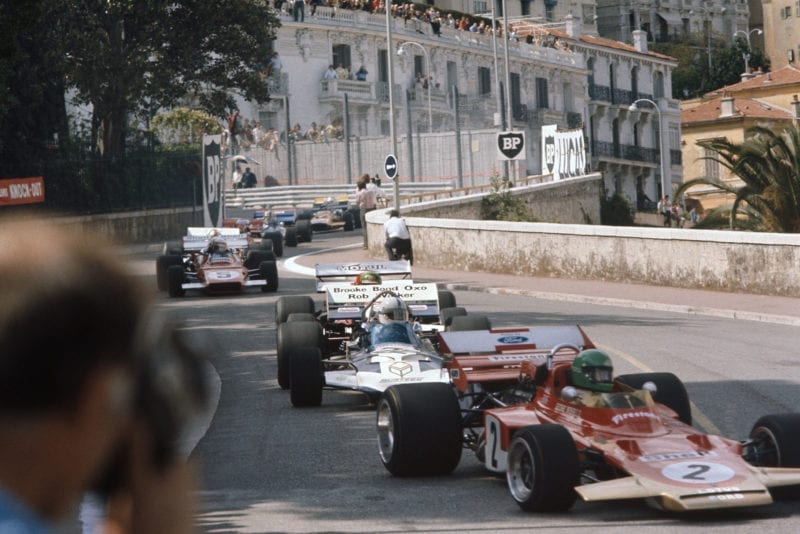
The pack heads into Loews hairpin
Motorsport Images
While the leader was putting on an impressive display of his superiority over everyone else in Grand Prix racing, and Peterson was giving his supporters something to support, those at the back of the field were having their various troubles. Amon had to stop and change a flat tyre, which put him even further back and with no hope of catching anyone. After his brake-locking incident and subsequent pit-stop, Rodriguez stopped again on the next lap as the car did not feel right, but nothing could be found wrong so he carried on. In the opening laps, on lap 4 to be precise, the tail-enders got all muddled up when Cevert stalled on the Gasworks hairpin and Schenken had to take violent avoiding action and broke both near-side wheels of his Brabham against the outside kerb. As the pits were only a little way away he was able to limp in and have two new wheels fitted and carry on. Two laps later Cevert clouted the edge of the track and damaged the rear of his Tyrrell, which stopped any further racing for him.
At 20 laps Stewart was away on his own, Siffert was second and Ickx third, but Peterson was closing steadily. Hulme was in fifth place and Beltoise sixth, though some way back having made an excursion up the escape road at the chicane on the harbour front. Then came a furious “follow-my-leader” group that looked fast and heated and probably was by their standards, but it was only seventh place that was at stake and you have to be higher than that to get into the World Championship stakes. This comprised Wisell (Lotus 72), Pescarolo (March 711), Regazzoni (Ferrari 312B/2), Stommelen (Surtees TS9), Fittipaldi (Lotus 72), with a clutch that was not freeing, Surtees (Surtees TS9) and Gethin (McLaren M14A), and as they all rushed into the relative darkness and shattering noise of the tunnel on the next lap, Pescarolo’s Hewland gearbox jumped out of fourth gear. By the time he was out in the sunlight again and had realised what had happened his rev.-counter was showing 11,200 r.p.m. and all except Gethin had shot past him.
This put Regazzoni behind Wisell and next lap, as they went along the sea-front towards the tunnel the Ferrari was nearly touching the Lotus. From all accounts Wisell muffed a gear-change, Regazzoni dodged the Ferrari sideways and struck the kerb which resulted in two broken wheels and flat tyres on the right-hand side and he limped to the pits for new ones. WiseII also stopped at the pits with a wobbly right-rear wheel, the hub race having broken up, which may have been caused by being struck by the Ferrari or it may not, no one was quite sure what happened in the general scramble. It all resulted in Wisell’s retirement and Regazzoni rejoining the race way down the field and out of contention. On lap 23 Gethin hit the edge of the track and bent the right-front suspension and that was his race over, and two laps later Regazzoni caught his right-rear wheel on the wooden barrier as he was leaving the chicane and this bent the rear suspension and spun him like a top. He recovered and retired at the pits.
Peterson’s meteoric drive in pursuit of the BRM and the Ferrari in second and third places was held up momentarily when he got behind Pescarolo, as he was lapping him, but then he went by and took the Ferrari as well, and in no time at all swept past the BRM on lap 31. He was throwing the March about as if he had gone mad, but it was all calculated and he didn’t bounce off anything, nor did the March fall to pieces under him, which surprised a lot of people. Although he was only 17 seconds away from Stewart after he had dealt with lckx and Siffert, the Scot was not troubled, and at 49 laps, which was half-distance, the gap was 18 seconds, soon to be increased to 20 seconds and 21 seconds, so it was all over.
With Wisell and Regazzoni out of the “also-rans” battle, and Pescarolo slowing with a deflating near-side rear tyre, Fittipaldi led the two Surtees cars, but the Brazilian had bumped a kerb somewhere and put the right-rear wheel out of line, with a bent top link mounting pin on the chassis, and a crack in the cross-member supporting it. Beltoise had another excursion up the escape road at the chicane, which let Fittipaldi into sixth place, and then both Matras disappeared within two laps, with a breakage in their Hewland final-drive units, Amon on lap 46 and Beltoise on lap 48. There were now only five cars on the same lap, Stewart in an unassailable lead, Peterson in a dominant second place, Siffert third and Ickx hanging on tenaciously, even though half his rear anti-roll bar mechanism had fallen in the road! Hulme was a lonely fifth, just driving round steadily for a finish.
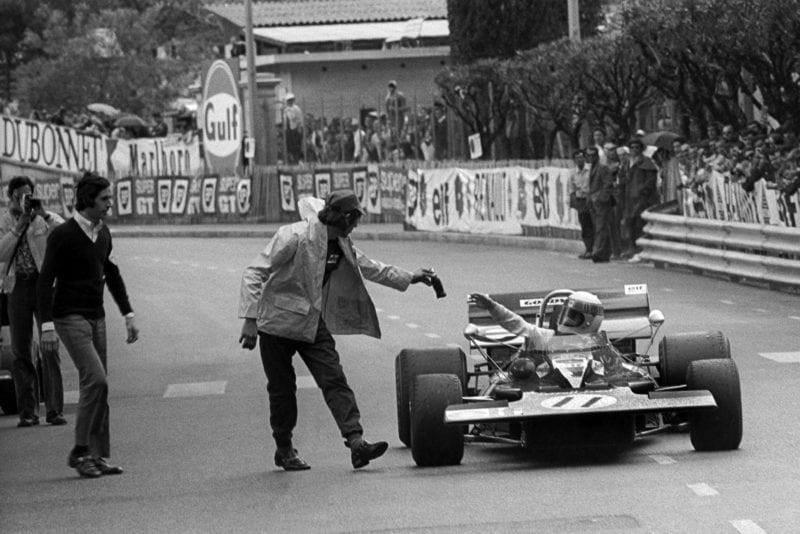
Stewart takes a well-earned drink after winning
Motorsport Images
As a race it was now a procession to the end with little hope of any last-minute excitement, and on lap 59 as Siffert accelerated away from the Gasometer hairpin an oil pipe broke and he saw his oil pressure gauge needle drop to zero, so he switched off hurriedly and came to rest, out of third place and the race. At the back of the field Stommelen and Surtees were running steadily and reliably, nose to tail, in sixth and seventh places and Pescarolo was bringing up the rear, apart from Rodriguez and Schenken who were many laps behind. As the 80 laps drew to a close grey clouds appeared over the town and the beady eyes of the race leader looked anxiously skywards as he went up the hill towards the Casino. The weather man was kind and the small pending shower held off until Stewart received the chequered flag, and then fell lightly as he went round on his slowing-down lap accompanied by great applause and appreciation from the great crowd.—D. S. J.
